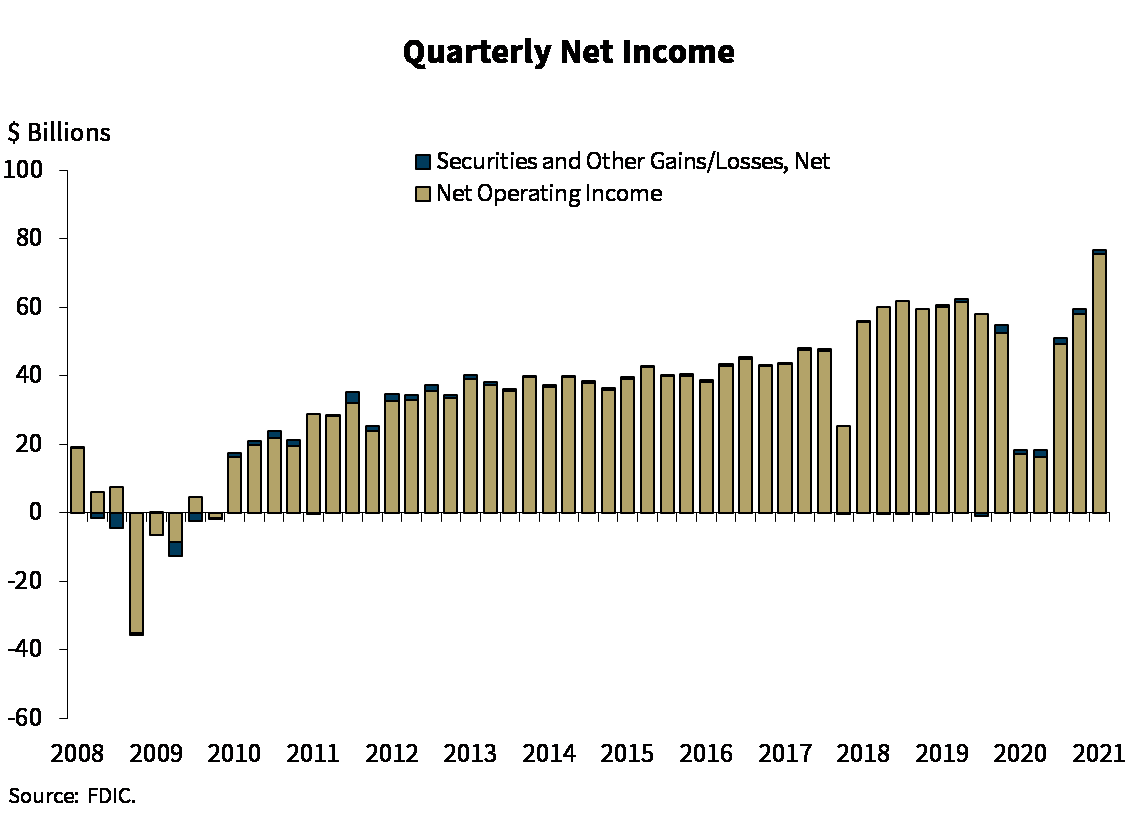FDIC-Insured Institutions Reported Net Income of $76.8 Billion In First Quarter 2021
For Release
- Quarterly Net Income Rose from a Year Ago Primarily Because of Negative Provisions for Credit Losses
- Net Interest Margin Contracted Further, Setting a Record Low
- Loan Balances Declined From the Previous Quarter and Year, Driven by a Reduction in Credit Card Balances
- Asset Quality Improved
- Community Banks Reported an Increase in Quarterly Net Income from a Year Ago
“The banking industry reported positive results for first quarter 2021, reflecting optimism about the pace of the economic recovery. However, a record low net interest margin and slow loan growth could challenge banks going forward.”
— FDIC Chairman Jelena McWilliams
WASHINGTON— Reports from the commercial banks and savings institutions insured by the Federal Deposit Insurance Corporation (FDIC) reflect aggregate net income of $76.8 billion in first quarter 2021, an increase of $58.3 billion (315.3 percent) from a year ago. Aggregate negative provision expense, reflecting improvements in the economy and asset quality, drove the increase in quarterly net income. Financial results for first quarter 2021 are included in the FDIC’s latest Quarterly Banking Profile released today.

“Despite continued challenges, the banking industry remains resilient. Strong capital and liquidity levels support lending needs and help protect against potential losses,” McWilliams said.
Highlights from the First Quarter 2021 Quarterly Banking Profile
Quarterly Net Income Increased 29.1 Percent from Fourth Quarter 2020: Net income totaled $76.8 billion, an increase of $17.3 billion (29.1 percent) from fourth quarter 2020. Aggregate negative provision expense bolstered both quarterly and annual net income growth. Three-fourths of all banks (74.8 percent) reported annual improvements in quarterly net income, and the share of unprofitable institutions dropped from 7.4 percent a year ago to 3.9 percent. The banking industry reported an aggregate return on average assets ratio of 1.38 percent, up 1 percentage point from a year ago and up 28 basis points from fourth quarter 2020.
Net Interest Margin Contracted Further to a New Record Low: The average net interest margin contracted 57 basis points from a year ago to 2.56 percent—the lowest level on record for the Quarterly Banking Profile . Net interest income fell by $7.6 billion (5.6 percent) from a year ago. The year-over-year reduction in yields on earning assets outpaced the decline in average funding costs, both of which are at record lows. Despite the aggregate decline in net interest income, which was driven by the largest institutions, more than three-fifths of all banks (64.4 percent) reported higher net interest income compared with a year ago.
Community Banks Reported a 77.5 Percent Increase in Quarterly Net Income Year-Over-Year: Community banks reported annual net income growth of $3.7 billion, supported by an increase in noninterest income and a decline in provision expense. Higher revenue from loan sales (up $1.3 billion or 126.4 percent) supported a 45 percent increase in noninterest income. Provision expenses declined $1.4 billion (78.4 percent) from a year ago, and $826.2 million (67.9 percent) from the previous quarter.
Nearly three quarters (73 percent) of the 4,531 FDIC–insured community banks reported higher quarterly net income. However, the net interest margin for community banks continued to narrow to the lowest level on record for the Quarterly Banking Profile , with a decline of 27 basis points to 3.26 percent, as the continued reduction in average earning asset yields outpaced the decline in average funding costs.
Loan Volume Continued to Contract, Driven by a Reduction in Credit Card Balances : Total loan and lease balances contracted $38.7 billion (0.4 percent) from the previous quarter. A reduction in credit card balances (down 7.4 percent) drove the quarterly decline in loan volume.
Compared with the year ago quarter, total loan and lease balances declined $136.3 billion (1.2 percent). This was the first annual contraction in loan and lease volume reported by the banking industry since third quarter 2011. Reduced commercial and industrial (C&I) loan (down 12.8 percent) and credit card balances (down 3.7 percent) drove the annual decline in loan volume.
Unlike the banking industry as a whole, community banks reported a 1.4 percent increase in loan balances from the previous quarter, led by strong C&I growth through participation in the Paycheck Protection Program (PPP). Annually, total loans and leases increased 10.8 percent—also led by loans originated through the PPP.
Asset Quality Improved: Loans that were 90 days or more past due or in nonaccrual status (noncurrent loans) declined $5.9 billion (4.6 percent) from fourth quarter 2020. The noncurrent rate for total loans declined 5 basis points from the previous quarter to 1.14 percent. Net charge-offs declined $5.4 billion (36.8 percent) from a year ago. The total net charge-off rate dropped 20 basis points to 0.34 percent.
The Deposit Insurance Fund’s Reserve Ratio Declined from the Previous Quarter to 1.25 Percent: The Deposit Insurance Fund (DIF) balance was $119.4 billion as of March 31, up $1.5 billion from the end of the fourth quarter. However, the reserve ratio declined four basis points to 1.25 percent, solely because of strong insured deposit growth.
Three New Banks Opened During the Quarter: Three new banks opened, and 25 institutions merged in first quarter 2021. No banks failed during the quarter.
